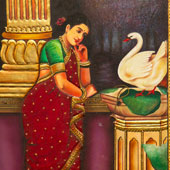Design Resource
Thanjavur Painting
The Art of Painting with Gemstone
by
Amruthalakshmi Rajagopalan, Anisha Crasto, and J. Antony William
Palagai (Wooden plank): Traditionally, wood of the pazha pazham maram (jack fruit tree) is used as it does not invite termites nor it rots easily. Now a days plywood is used.
Attai (Cardboard)
Gada cloth (Cotton fabric)
Kezhungu passai (Indigenous gum): Gum from a root used for sticking cloth to the wooden base.
Chukangu powder (A root ground to powder): Used with fevicol as to coat the fabric.
Sunnambu kallu (Calcium carbonate stone): The stone is ground and sieved to fineness and used with chalk powder and gum from the karuvela maram for coating on cloth.
Polishing stone and Emery sheet: For smoothening the coated board in preparation for tracing the image.
Red stone: It is used in the past instead of sunnambu kallu for embossing work. It was mixed with chalk powder and gum. Red stone is believed to be longer lasting than sunnambu kallu.
Fevicol: Used with chukangu powder to create a maavu (paste) for coating the cloth.
Karuvela maram gondhu (Gum from the babul tree)
Chalk powder: Used in the coating of cloth.
Tracing sheet with a template for the painting.
Kari (Charcoal dust): Used to create impression of tracing on board.
Mai (Soot from vellakanni deepam): Used for preliminary outlining with brush. Also used for detailing the gold leaf embossing.
Kundan stones: Bought from Jaipur for the jeweled parts of the painting. Based on orders, precious stones are used instead of kundan.
Kannaadi (Glass): Traditionally, glass was cut into required shapes using a diamond cutter. The cut glass, set in lac on a stick is then shaped by rubbing on a stone till it has soft curves. The glass is then placed on a silver plate with colour smeared on it. On heating the silver plate, the colour sticks to the glass. This coloured glass has better luster as compared to the kundan used today. Mirror is used for decorating borders. It was earlier made by artisans by setting padarasam (mercury) under clear glass.
Lac: Used for fixing glass pieces to sticks for shaping.
Gold leaf: A thin film of flattened gold. Made by artisans in the past by beating a gold bit by placing it on a thol (animal skin). In the 1930s and 40s it was imported from China. Now, gold leaf is procured from Jaipur. Fake gold leaf is available in Thanjavur and is used by many painters.
Scissor : For cutting gold leaf to size.
Cloth : for pressing emboss work.
Anil vaal brush (Squirrel tail hair brush): Made by the artisan according to required thickness.
Poster colors and opaque water colours: When used directly, the colors are stark, creating high contrasts. They are often used with a few drops of mooligai colours for a slightly subdued rendering.
Mooligai colours (pigments extracted from natural sources like leaves, root and bark): These colors are available at naatu marundhu kadaigal (country medicine stores) in the form of tablets or powders. These colors are grinded/churned and mixed with gum and water. The preparation of colors takes about two to four days and has a limited shelf life. Painting with natural colors creates a subdued tonal effect as compared to the stark effect of poster colors.
Other materials used are: Teak wood for frame and glass placed over painting.











